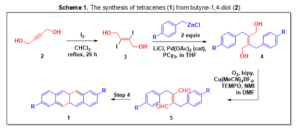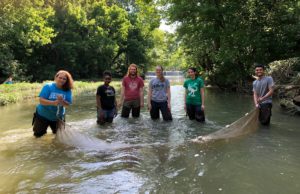Dr. Mary Robert Garrett
Dr. Mary Robert Garrett and her research team investigated the sustainable production of electron-deficient tetracenes(1), four-ringed, polyaromatic compounds, which have demonstrated promise as thermoelectric (TE) materials. This project examined an alternative approach to tetracenes (Scheme 1, below) that would lend itself to electron-deficient substrates in addition to electron-rich, and neutral substrates. Dr. Garret and her team successfully synthesized compound 5 from compound 2 via the three reported steps for an electron-rich substrate (R = CH3), electron-neutral substrate (R = H), and an electron-deficient substrate (R = F). The neutral product was synthesized in 20% yield, the electron-rich product in 49% yield and the electron-deficient product in 22% yield. As a result of this successful work, a new course has been developed for the Spring 2020 semester to continue this project in hopes of completing the fourth and final step realizing the only synthesis of electron-deficient substrates that also applies to electron-rich and neutral compounds. Upon that successful completion, the potential of these compounds to control electron flow in applications such as solar panels will be explored.



Recent Comments